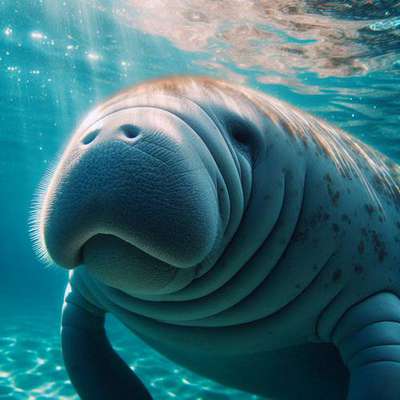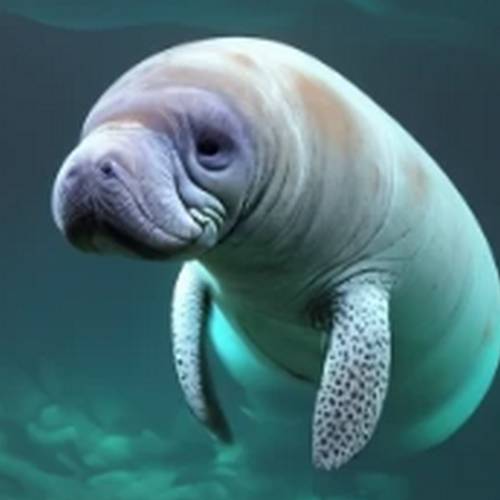What Do Manatees Love to Feed On?
Manatees, often called sea cows, comprend these species:
-West Indian Manatee (Trichechus manatus): This is the most widespread and well-known species. It's further divided into two subspecies:
- Florida Manatee (T. m. latirostris): Found primarily in southeastern US waters.
- Antillean Manatee (T. m. manatus): Inhabits coastal areas and rivers of the Caribbean Sea and the northern coast of South America.
- Amazonian Manatee (Trichechus inunguis): As the name suggests, it's found exclusively in the Amazon River basin of South America. This species is unique for lacking nails on its flippers.
- African Manatee (Trichechus senegalensis): Inhabits the west coast of Africa, found in rivers, estuaries, and coastal areas.
The gentle giants of the aquatic world with a hearty appetite for plants. These herbivorous marine mammals have a diverse palate when it comes to their favorite foods.
Their diet primarily consists of aquatic vegetation found in the warm, shallow waters they inhabit. Manatees use their sensitive, bristled snouts and flexible upper lips to grasp and manipulate plants into their mouths. They're not picky eaters and will consume a wide variety of aquatic plants to meet their nutritional needs.
Here's a list of some of the foods manatees love to feed on:
- Seagrasses (e.g., turtle grass, manatee grass)
- Freshwater plants (e.g., hydrilla, water lettuce)
- Mangrove leaves
- Water hyacinth
- Eelgrass
- Algae
- Cordgrass
- Widgeon grass
- Shoal grass
- Pennywort
- Smooth cordgrass
- Duckweed
- Water lilies
- Floating plants like water lettuce and water hyacinth
- Various types of marine algae
Manatees are opportunistic feeders and may occasionally consume small fish or invertebrates that get caught in the vegetation they're eating, but this is not a significant part of their diet. Their love for aquatic plants makes them important contributors to the health of their ecosystems by helping to control vegetation growth in the waters they inhabit.
-West Indian Manatee (Trichechus manatus): This is the most widespread and well-known species. It's further divided into two subspecies:
- Florida Manatee (T. m. latirostris): Found primarily in southeastern US waters.
- Antillean Manatee (T. m. manatus): Inhabits coastal areas and rivers of the Caribbean Sea and the northern coast of South America.
- Amazonian Manatee (Trichechus inunguis): As the name suggests, it's found exclusively in the Amazon River basin of South America. This species is unique for lacking nails on its flippers.
- African Manatee (Trichechus senegalensis): Inhabits the west coast of Africa, found in rivers, estuaries, and coastal areas.
The gentle giants of the aquatic world with a hearty appetite for plants. These herbivorous marine mammals have a diverse palate when it comes to their favorite foods.
Their diet primarily consists of aquatic vegetation found in the warm, shallow waters they inhabit. Manatees use their sensitive, bristled snouts and flexible upper lips to grasp and manipulate plants into their mouths. They're not picky eaters and will consume a wide variety of aquatic plants to meet their nutritional needs.
Here's a list of some of the foods manatees love to feed on:
- Seagrasses (e.g., turtle grass, manatee grass)
- Freshwater plants (e.g., hydrilla, water lettuce)
- Mangrove leaves
- Water hyacinth
- Eelgrass
- Algae
- Cordgrass
- Widgeon grass
- Shoal grass
- Pennywort
- Smooth cordgrass
- Duckweed
- Water lilies
- Floating plants like water lettuce and water hyacinth
- Various types of marine algae
Manatees are opportunistic feeders and may occasionally consume small fish or invertebrates that get caught in the vegetation they're eating, but this is not a significant part of their diet. Their love for aquatic plants makes them important contributors to the health of their ecosystems by helping to control vegetation growth in the waters they inhabit.
What is a Manatee's Favorite Food?
While this animal aren't picky and happily munch on over 60 different aquatic plants, if you were to peek at their dinner plate most often, you'd find seagrass. This underwater meadow is their absolute favorite, making up the bulk of their diet - we're talking up to 10% of their body weight in seagrass every single day!
That's like a 1,000-pound manatee polishing off around 100 pounds of salad! This love for seagrass makes sense - it's packed with nutrients, easily digestible, and grows abundantly in their watery homes. So, while they appreciate a varied menu, seagrass is the ultimate comfort food for these gentle giants.
That's like a 1,000-pound manatee polishing off around 100 pounds of salad! This love for seagrass makes sense - it's packed with nutrients, easily digestible, and grows abundantly in their watery homes. So, while they appreciate a varied menu, seagrass is the ultimate comfort food for these gentle giants.
Do this Creature Eat Freshwater Plants or Saltwater Plants?
Manatees, those gentle giants often called "sea cows,"
are known for their love of aquatic plants. But does their menu change depending on whether they're swimming in a salty bay or a freshwater river? The answer might surprise you!
Here's the thing:
manatees aren't picky eaters when it comes to freshwater vs. saltwater plants. They've adapted to thrive in both environments, and their digestive systems can handle a variety of aquatic vegetation.
• In salty coastal waters: Seagrass reigns supreme. These underwater meadows are like all-you-can-eat buffets for manatees, with favorites like manatee grass and shoal grass topping the menu.
• Venturing into freshwater rivers and springs: Manatees happily munch on plants like pickerelweed, water hyacinth, and even some algae. Think of it like switching from a salad to a delicious veggie platter.
This adaptability is key to their survival. It allows manatees to:
• Follow the Food: They can migrate between different habitats depending on where the best food sources are located, especially during seasonal changes.
• Escape Harsh Conditions: If water temperatures become too cold in the ocean, manatees can head inland to warmer freshwater springs.
So, whether it's a salty seagrass salad or a freshwater veggie mix, manatees are happy to graze wherever their powerful tails take them. Their ability to utilize both freshwater and saltwater plants makes them incredibly resilient and adaptable creatures.
are known for their love of aquatic plants. But does their menu change depending on whether they're swimming in a salty bay or a freshwater river? The answer might surprise you!
Here's the thing:
manatees aren't picky eaters when it comes to freshwater vs. saltwater plants. They've adapted to thrive in both environments, and their digestive systems can handle a variety of aquatic vegetation.
• In salty coastal waters: Seagrass reigns supreme. These underwater meadows are like all-you-can-eat buffets for manatees, with favorites like manatee grass and shoal grass topping the menu.
• Venturing into freshwater rivers and springs: Manatees happily munch on plants like pickerelweed, water hyacinth, and even some algae. Think of it like switching from a salad to a delicious veggie platter.
This adaptability is key to their survival. It allows manatees to:
• Follow the Food: They can migrate between different habitats depending on where the best food sources are located, especially during seasonal changes.
• Escape Harsh Conditions: If water temperatures become too cold in the ocean, manatees can head inland to warmer freshwater springs.
So, whether it's a salty seagrass salad or a freshwater veggie mix, manatees are happy to graze wherever their powerful tails take them. Their ability to utilize both freshwater and saltwater plants makes them incredibly resilient and adaptable creatures.



